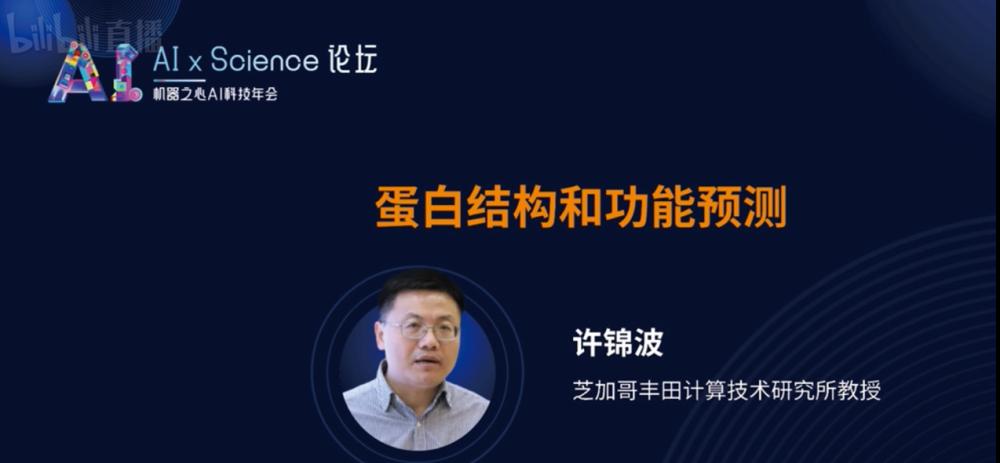On March 23, at the "AI Technology Annual Conference" hosted by the Heart of Cutting-edge Technology Media Machine, Professor Xu Jinbo of toyota Institute of Computing Technology in Chicago announced in his speech that he would return to China and join the national laboratory, and shared the development history and latest progress of AI prediction protein structure and function in this emerging field.
Xu Jinbo is known as "the world's first person in AI to predict protein structure", as early as 2016, he developed the RaptorX-Contact method, which for the first time proved the feasibility of deep learning methods to predict protein structure, and opened the prelude to the era of AI protein structure prediction. The AlphaFold software developed by Google DeepMind is also based on the previous research results of Xu Jinbo's team.

Xu Jinbo said that accurately describing the structure and function of proteins is the basis for understanding life processes. The structure and function of proteins are closely linked, and predicting the structure of proteins helps people understand the function of proteins at the atomic level. In recent years, with the rise of artificial intelligence again, the structural prediction of proteins has rapidly moved from traditional physical and statistical methods to the latest machine learning and even deep learning algorithms. Deep learning technology subverts protein structure prediction, can correctly predict 90% of protein shape, of which 50-60% of proteins can do high-resolution prediction, on this basis, to promote the molecular biology community's research paradigm from sequence-based research to structure-based research, thereby promoting structure-based drug discovery and design, improving the efficiency of protein de novo design.
As we all know, cells are the basic units that make up living organisms, and proteins are important living substances that make up cells, and are the embodiment and undertaker of life activities. Among them, the composition of protein molecules and their folding structure determines to a large extent the biological functions that proteins have and are playing. However, how to clearly "understand" the folded structure of proteins is a "century of puzzles" that plague the biological community. Once unraveled, humanity's understanding of life will take a leap forward.
Taking the current hot biomedical industry as an example, a series of biomedical products manufactured by cells, tissues, body fluids, etc., such as monoclonal antibodies, recombinant proteins, vaccines and gene and cell therapy drugs and other macromolecular drugs, because the efficacy is generally higher than that of chemical drugs and the toxic side effects are small, in recent years, the medical industry has received more and more attention, and the market scale growth rate is much higher than that of chemical drugs. Predicting the structure and function of proteins through AI can help people deeply understand the pathogenesis of many stubborn diseases, including cancer, genetic diseases, etc., and then find a more accurate path for treatment; at the same time, the optimization of protein structure with the help of AI can also greatly improve the efficiency of the research and development of macromolecular drugs and reduce costs.
In addition to the medical industry, because protein can be used as a biological catalyst such as enzymes and hormones, it has a wide range of applications in many fields such as food, chemical industry, energy, environmental engineering, etc. It is conceivable that using AI to solve the mystery of protein structure and carry out structural design and optimization on this basis can bring about earth-shaking changes to future social development.
In the past six years, Xu Jinbo has made pioneering contributions in the field of AI protein structure prediction.
In 2016, Xu Jinbo developed the RaptorX-Contact method based on residual network (ResNet), which adopts a global structure prediction method to migrate the image segmentation technology in image processing to the field of protein structure prediction, uses deep learning convolutional networks to calculate the protein structure as a whole, and reconstructs the three-dimensional structure of protein molecules through the distance matrix, thereby greatly improving protein structure prediction. That same year, raptorX-Contact scored first in the Twelfth International Critical Assessment of Protein Structure Prediction (CASP), known as the "Olympiad in protein structure prediction," in predicting protein contact matrices. This core idea of protein structure prediction has been valued by Google's DeepMind team and applied to the development of AlphaFold.
In addition to pioneering new ideas for AI protein prediction, Xu Jinbo's team has also developed several well-known bioinformatics software, including the protein interaction network analysis software IsoRank. Since last year, Xu Jinbo's team has continued to use residual networks (ResNet) to achieve higher levels of protein structure prediction without using co-evolution information, and performed even better at predicting the structure of artificially designed proteins. This development is of great significance for both protein engineering and protein design.
Professor Xu Jinbo will join the Changping Laboratory in Beijing, which focuses on the field of life sciences and represents the national strategic scientific and technological strength, and will continue to carry out scientific research around protein prediction and design here.